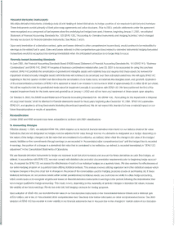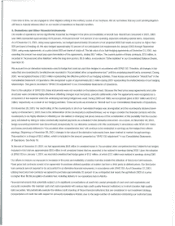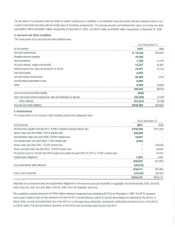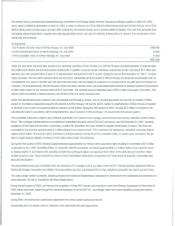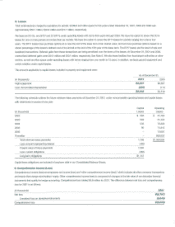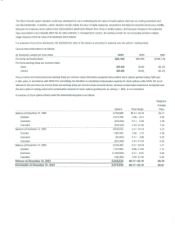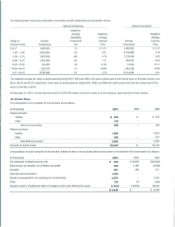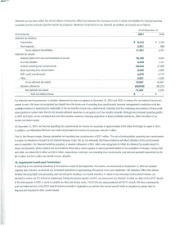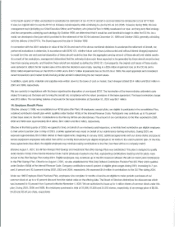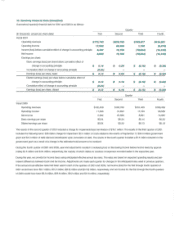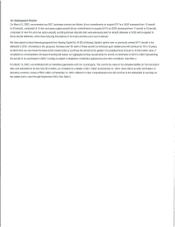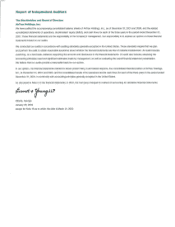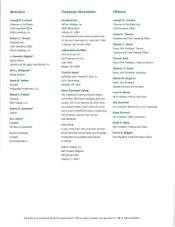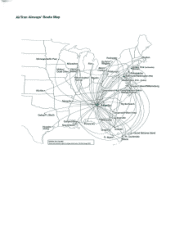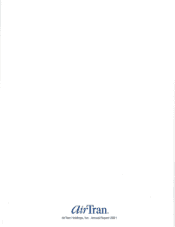Airtran 2001 Annual Report Download - page 38
Download and view the complete annual report
Please find page 38 of the 2001 Airtran annual report below. You can navigate through the pages in the report by either clicking on the pages listed below, or by using the keyword search tool below to find specific information within the annual report.
In
the fourth quarter
of
1999, we decided to accelerate the retirement
of
our 42 DC-9 aircraft to accommodate the introduction
of
our 8717 fleet.
It
was our original intent to use the 8717s to increase overall capacity while continuing to use the DC-9s into 2005. However, during 1999, the new
management team (including our Chief Executive Officer and President, who joined AirTran
in
1999) reevaluated our near- and long-term fleet strategy
and the components underlying such strategy.
8y
October 1999, we determined that
it
would be cost-beneficial to begin to retire the DC-9s. As a
result,
we
developed afleet plan which provided for the retirement
of
the DC-9s between December
31,
1999 and October 2003, generally coinciding
with the delivery of the 8717s. The
80ard
approved the plan
in
October 1999.
In
connection with the 2001 reduction in value
of
the DC-9s and each
of
the above mentioned decisions to accelerate the retirement
of
aircraft,
we
performed evaluations to determine,
in
accordance with
SFAS
121,
whether future cash flows (undiscounted and without interest charges) expected
to result from the use and eventual disposition
of
these aircraft would be less than the aggregate carrying amount
of
these aircraft and related assets.
As aresult
of
the evaluations, management determined that the estimated future cash flows expected to
be
generated by these aircraft would be less
than their carrying amounts, and therefore these aircraft are impaired as defined by
SFAS
121.
Consequently, the original cost bases
of
these assets
were reduced to reflect the fair market value at the date the decisions were made, resulting
in
a$28 million impairment loss on the DC-9s and a
$10.8 million impairment loss on the
8737s
in 2001 and a$147.7 million impairment loss on the DC-9s in 1999. We used appraisals and considered
recent transactions and market trends involving similar aircraft
in
determining the fair market values.
In
addition, spare parts, materials and supplies were written down to the lower
of
cost or market. Such charges totaled $3.4 million and $5.9 million in
2001 and 1999, respectively.
We
are currently in negotiations with the lessor regarding the disposition
of
one leased 8737. The termination
of
the lease includes estimated costs
related to buying out the lease and to bring the aircraft into compliance with the return provisions
of
the lease agreement. The lease termination charge
was $7.3 million. The remaining balance
of
accruals for the lease termination at December
31,
2001 was $6.7 million.
14. Employee
Benefit
Plans
Effective January
1,
1998, we consolidated our 401(k) plans (the Plan).
All
employees, except pilots, are eligible to participate
in
the consolidated Plan,
adefined contribution benefit plan which qualifies under Section 401(k)
of
the Internal Revenue Code. Participants may contribute
up
to
15
percent
of
their base salary to the Plan. Contributions to the Plan by AirTran are discretionary. The amount
of
our contributions to the Plan expensed
in
2001,
2000 and 1999 were approximately $0.3 million, $0.5 million and $0.3 million, respectively.
Effective
in
the third quarter
of
2000,
we
agreed to fund, on behalf
of
our mechanics and inspectors, amonthly fixed contribution per eligible employee
to their union's pension plan.
In
May
of
2001, asimilar agreement was made on behalf
of
our maintenance training instructors. During 2001,
we
expensed approximately $0.2 million related to these agreements. 8eginning
in
January 2002, additional agreements with our stores clerks and ground
service equipment employees take effect that call for amonthly fixed amount per eligible employee to be made to the union's pension plan. At the time
these agreements take effect, the eligible employee may continue making contributions to the Plan, but there will be no company match.
Effective August
1,
2001, the AirTran Airways Pilot Savings and Investment Plan (Pilot Savings Plan) was established. This plan is designed to qualify
under Section 401{k)
of
the Internal Revenue Code. Funds previously invested
in
the Plan, representing contributions made by and for pilots, were
moved to the Pilot Savings Plan during 2001. Eligible employees may contribute up to the
IRS
maximum allowed. We will not match pilot contributions
to this Pilot Savings Plan. Effective on August
1,
2001, we also established the Pilot-Only Defined Contribution Pension Plan (DC Plan) which qualifies
under Section 403(b)
of
the Internal Revenue Code. Company contributions were 6percent
of
eligible gross wages during 2001, increasing to 7
per~
cent, 8percent and 10.5 percent during 2002, 2003 and 2004, respectively. We expensed $1.8 million in contributions to the DC Plan during 2001.
Under our 1995 Employee Stock Purchase Plan, employees who complete 12 months
of
service are eligible to make periodic purchases
of
our
common stock at up to a15 percent discount from the market value on the offering date. The 80ard
of
Directors determines the discount rate which
was increased to
10
percent from 5percent effective November
1,
2001. We are authorized to issue
up
to 4million shares of
common
stock under this
plan. During 2001,
2000
and 1999, the employees purchased atotal
of
31,396,61,626
and 51,318 shares, respectively, at an average price
of
$6.93,
$4.30 and $3.94 per share, respectively.


